
I love the thinginess of things. —Sylvia Plath
1. Black Telephone.
Court Green, Sylvia Plath and Ted Hughes’s manor house. North Tawton, Devon, England. July 9, 1962. Aurelia Plath was visiting from the States, and mother and daughter had just returned from a shopping trip in Exeter. Earlier in the day, Plath had proudly told Aurelia, “I have everything in life I’ve ever wanted: a wonderful husband, two adorable children, a lovely home, and my writing.” In Exeter she bought a 9’ x 12’ sisal rug for the playroom (black and red herringbone weave), a black cashmere sweater and full black wool skirt (with broad geometric border above the hemline) for herself, and two shirts for Hughes. Sylvia and Aurelia ate at the Royal Clarence Hotel. They drank wine with their lunch and, deciding to cut their excursion short, headed back to Court Green in high spirits. When they arrived at the house, the phone was ringing. Sylvia hurried inside and answered it. The woman on the other end of the line pretended to be a man. Sylvia was not fooled by this ruse: she knew it was Assia Wevill, the woman with whom Hughes was having an affair. By now Ted had descended the stairs from his attic study. Sylvia stonily handed him the phone. Ted spoke to the “man” and hung up. Sylvia angrily pulled the phone cord out of the wall.
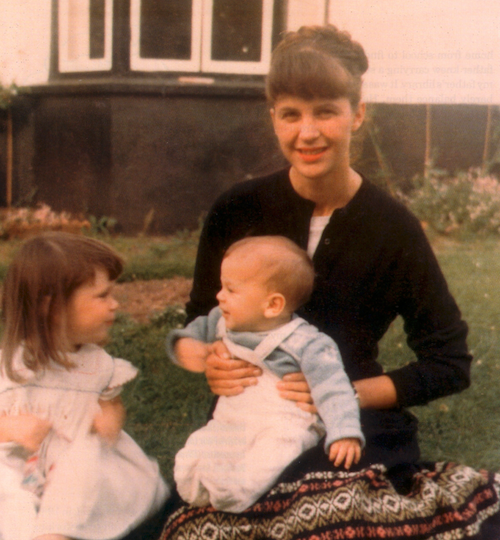
This is the telephone incident that precipitated the end of Sylvia Plath and Ted Hughes’s marriage. It reverberates in such Plath poems as “Words heard, by accident, over the phone,” “The Fearful” (“This woman on the telephone / Says she is a man, not a woman”), and “Daddy”: “The black telephone’s off at the root, / The voices just can’t worm through.” I believe Hughes is revisiting the telephone incident in “Do Not Pick Up the Telephone”: “A flame from the last day will come lashing out of the telephone / A dead body will fall out of the telephone.” The black telephone becomes a “trauma object” for both poets, an instrument of terror as in the movies Sorry, Wrong Number and Midnight Lace. So deeply have I “fallen” into Plath research, I know that the Devon telephone number, before she severed the connection in July 1962, was North Tawton 370; after it was reinstalled a few months later, in early November, it changed to North Tawton 447. I was surprised to discover that Plath was without phone service when she wrote the bulk of her Ariel poems that October.
Certain that Plath would have appreciated my attention to detail, I had to find out the model of her telephone. It would have been from the 700 series (706, to be exact), available in Britain from 1959 to 1967; “subscribers” rented their phones from the General Post Office and had to wait several months to have them “fitted” by a GPO engineer. Ironically, this interval during which Plath was cut off from the rest of the world helped facilitate her great poetic output: she was stuck in what she called a “sack of black,” writing against ”blackness and silence.” Of course once I knew the model, obsessiveness (or should I say fetishism) led me to Ruby Tuesday, a store in Shropshire that sells vintage telephones on eBay. From them I bought (for £65, plus another £30 for postage) an example of the very phone Sylvia angrily ripped from the wall. It sits here on my desk, magical by association, and beautiful (to my mind) in its shiny black obsolescence.
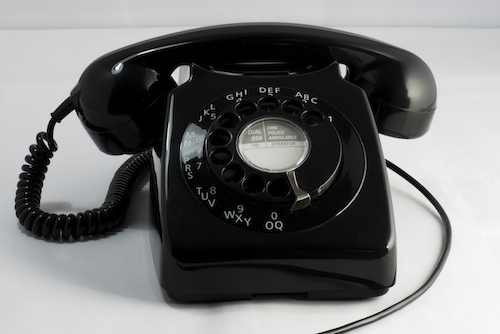
2. Liberty of London Scarf.
When Aurelia Plath arrived in North Tawton on June 21, 1962, Sylvia gave her a tour of the Court Green grounds, then led her to the guest room. Aurelia was moved by the makeover Sylvia had given it: the threshold was painted a glossy black and decorated with a hearts-and-flowers motif (hand-painted by Plath); Sylvia’s old trunk had been transformed with a new coat of black paint and the same hearts and flowers; propped against a pillow was a small package (the wrapping paper had bouquets of pansies and roses) with a message in Sylvia’s hand: “For mother ~ welcome to Court Green ~ from Sivvy & Ted.” Inside was a scarf from Liberty of London. In her travel journal, Aurelia describes it as having a blue-and-green stained-window design. It was the last gift Sylvia would ever give her mother.
Aurelia included the scarf (still in its original wrapping, never worn) with Plath’s papers when she sold them to Indiana University in 1977. I came across it when I was looking through a file of Plath’s letters on a research trip in 2008. Photographs weren’t allowed, so I drew a sketch of it in my notebook:
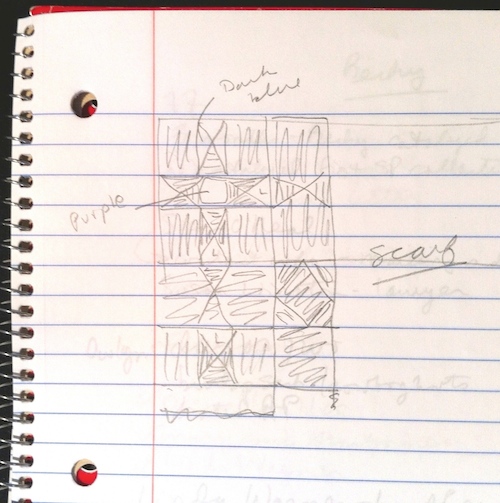
Over the next couple of years, I would periodically search eBay for “vintage Liberty of London scarf.” I felt that the exact one Sylvia bought for Aurelia would eventually turn up. Finally, in July 2010, it did. I won it for just $10.49. (I would have paid much more.)
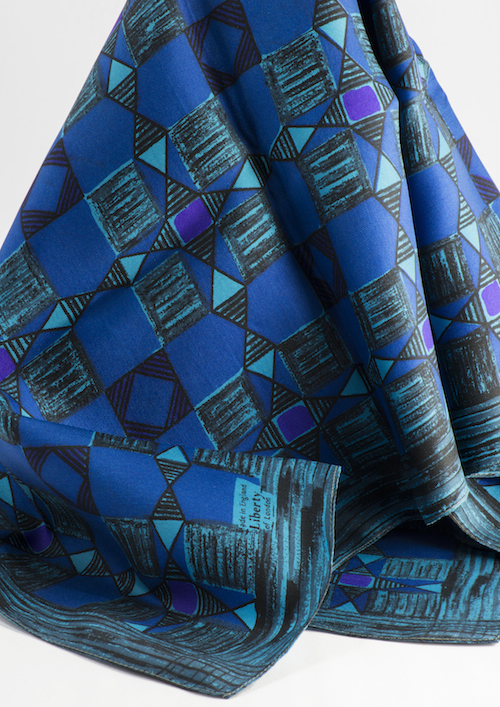
3. Magazines.
There’s a special kind of thrill I get when I hold one of the magazines in which Plath published her poems. Why I would get such a thrill is obvious, right? Please don’t ask me to explain it. These are some of the magazines I’ve collected. “Tulips” was published in the April 7, 1962 issue of The New Yorker. “Blackberrying” appeared later in the year, in the September 15 issue. This would be the last poem of hers Plath saw in the pages of The New Yorker, the magazine she considered (rather desperately) the pinnacle of success. At the time of her death (February 11, 1963), The New Yorker had six of her poems that they’d accepted but not yet published: “Two Campers in Cloud Country,” “Elm” (as “The Elm Speaks”), “Amnesiac,” “Mirror,” “Among the Narcissi,” and “The Moon and the Yew Tree.” These would be published posthumously, in a two-page spread, in their August 3, 1963 issue.

The story of Plath’s poetry acceptances toward the end of her life is an interesting one. A myth has grown up that Plath was unable to place many of her Ariel poems with magazines, and therefore felt they were a failure. Not quite. Poetry accepted three poems (“Eavesdropper,” “Fever 103°,” “Purdah”), The Atlantic accepted two (“The Arrival of the Bee Box,” “Wintering”), and The New Yorker, as I’ve said, had six in their queue. In London, Plath had her supporters. A. Alvarez at The Observer accepted “Ariel” (which would be published as “The Horse”), “Poppies in October,” and “Winter Trees.” Alan Ross and Charles Osborne at The London Magazine liked Plath’s work a great deal. In November 1962 they accepted “The Applicant” and “Stopped Dead”; in late January 1963 (two and a half weeks before Plath’s suicide) they took nine: “An Appearance,” “The Bee Meeting,” “Berck-Plage,” “The Couriers,” “Cut,” “Letter in November,” “Mary’s Song,” “Stings,” and “Years.” Osborne raved to Plath about her new poems in his acceptance note. By 1986, when he published his memoirs, he seems to have chilled a smidgen. He remembers Plath thusly: “Vulnerability and tantrums are what I most associate with Sylvia at this time. The poems impressed me despite themselves. They were not the kind of poems I liked, but some of them were remarkable.”
“Winter Trees” was published in the January 13, 1963 issue of The Observer. “Stopped Dead” and “The Applicant” came out in the January issue of The London Magazine. These were the final poems that Plath saw into print.

4. Morris Traveller.
In 1961, while still living in London, Plath and Hughes decided to purchase a car. Plath wrote to Aurelia on March 27: “We are very happy, looking forward to getting a small station wagon . . . Then we can really take advantage of our life: going on country & Cornwall trips when other people have to work, avoiding traffic & holidayers & being portable with babies.” In April, Hughes was taking driving lessons in preparation for obtaining a British license. They’d settled on the Morris Minor 1000 Traveller—a compact black station wagon with light wood trim and red upholstery. It got forty-plus miles to the gallon; Plath gathered that this was rather wonderful. “Poetry prizes of the last two years will just about buy it,” remarked Hughes. “We haven’t got one before because I refuse to buy a second-hand car here—knowing as little as I do about them—unless it’s an old insect for £10 or so, and Sylvia refuses to buy that sort. So we’re getting a new one.” The new car cost them $1,876.00.


When Hughes moved out of Court Green in the fall of 1962, he left the Morris with Plath. This is the car, then, that she drove off the road (according to Alvarez) in a supposed suicide attempt; the car she moved herself and her children to London in; that she drove about London in her final weeks, in extreme weather conditions. Elizabeth (Compton) Sigmund, Plath’s friend in Devon (The Bell Jar is dedicated to her and her former husband David), remembers the car well. During a phone conversation in 2009, Sigmund told me she had a Corgi model of Plath’s black Morris Traveller sitting on her desk. “I do, too!” I exclaimed. We cracked up. “I think Sylvia would be laughing her head off if she could hear us talking,” Elizabeth said.

5. Postcards.
Plath and Hughes’s 1959 road trip across America. Plath sent her relatives (mostly Aurelia) sixteen postcards and a handful of letters during their eight-week cross-country vacation. These enabled me to recreate, in great detail, not only the route they took, but many of their experiences along the way (here). While working on this piece, I drank Ovaltine when Sylvia and Ted drank it—in Yellowstone Park, where one night a bear broke into their car (see Plath’s short story “The Fifty-Ninth Bear”). I thought it tasted dreadful; I hadn’t had it since I was a kid. It wasn’t until I mentioned this to D.A. Powell that I learned I’d been making it incorrectly: I’d been adding water instead of milk. (It helps to read the directions.) For only $9.99 I bought (on eBay, where else) a 1959 American Geographical Society map of the United States that shows the major thoroughfares of the time. I took a car from my vintage Game of Life, stuck a blue peg and pink peg in it, and moved it along the map as Sylvia and Ted traveled across the country. I also started collecting (again via eBay) the same postcards that Sylvia selected to send. So far I’ve only been able to locate five of them:

6. Tarot Book.
I’ve been reading Tarot cards since the seventies. I don’t think I’m all that good at it. Some poets are quite gifted, though. If you’re lucky, you’ll get Hoa Nguyen, Maureen Seaton, or Tony Trigilio to give you a reading. Imagine Sylvia Plath reading your cards. Hughes gave Plath her Tarot deck in 1956, for her twenty-fourth birthday, when Plath was still a student at Newnham College at Cambridge University. Sylvia to Aurelia: “We celebrated my birthday yesterday: he gave me a lovely Tarot pack of cards and a dear rhyme with it, so after the obligations of this term are over your daughter shall start her way on the road to becoming a seeress & will also learn how to do horoscopes, a very difficult art which means reviving my elementary math.” Who knows where her deck ended up. But her Tarot book, Basil Ivan Rákóczi’s The Painted Caravan: A Penetration Into the Secrets of the Tarot Cards (with “Sylvia Plath London—1956” inscribed on the flyleaf), ended up in the Mortimer Rare Book Room at Smith College. Naturally I had to have the same Tarot book that Sylvia had. Call me crazy: I paid $135.00 for this book. I don’t know that it’s improved my skills as a seer.
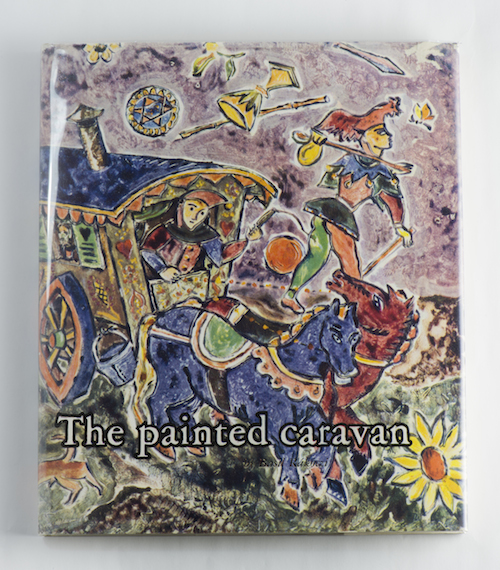
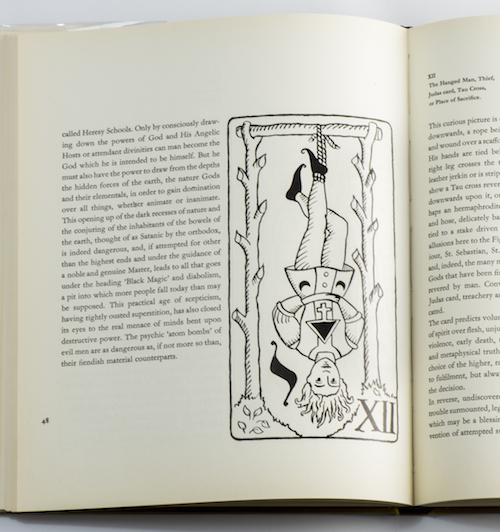
7. Wildflower Book.
Another gift from Ted to Sylvia—The Oxford Book of Wild Flowers—by way of Aurelia Plath. In March 1961, Aurelia sent Sylvia ten dollars: Sylvia had had an appendectomy the previous month, and mother wanted daughter to treat herself to something. Sylvia was ever grateful. Out of hospital, recovering at home, she wrote to Aurelia on March 17: “I so appreciated your $10: Ted got me, on my orders, a stack of DH Lawrence—novels & stories & travelbooks, which I’ve been reading: the only diet I felt like. I’ll use the remains to buy a fine art-book when I take my 1st trip downtown.” Ten days later, in another letter: “Ted brought me a little bouquet of yellow primroses yesterday with a handsome edition of the Oxford Book of Wild Flowers—the remains of that kind $10 you sent. He is the sweetest most thoughtful person in the world. I have had a rather glum winter & he has tirelessly stood by & cheered me up in every conceivable way.” It’s no wonder Plath was glum: she’d had a miscarriage on February 6 and her appendix removed on February 28.
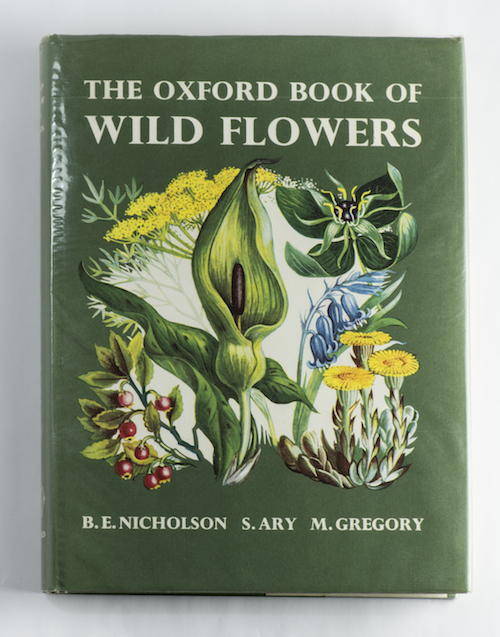
Two wildflowers that Plath’s poems made famous are the poppy and the cornflower. She mentions both in a letter she wrote to novelist Olive Higgins Prouty (Plath’s benefactress) on October 25, 1962. (This letter has yet to be published.) Hughes was gone from Court Green. Plath had written poem after poem throughout the month of October; she was high on her achievement. The morning of the 25th she’d written “The Tour,” a revenge poem directed at another (would-be) benefactress, Marianne Moore. In the letter, Plath says that her study has become her haven. On her desk at that moment are late, bright red poppies and blue-purple cornflowers. She plans to make curtains for her study—of a red-and-purple stained-glass pattern—to match the rug. She’s never been so happy in her life as writing at her desk in the blue dawns, all to herself, secret and quiet. The quiet center of the storm. Two days later, on her thirtieth birthday, she would write “Poppies in October,” in which both wildflowers feature.
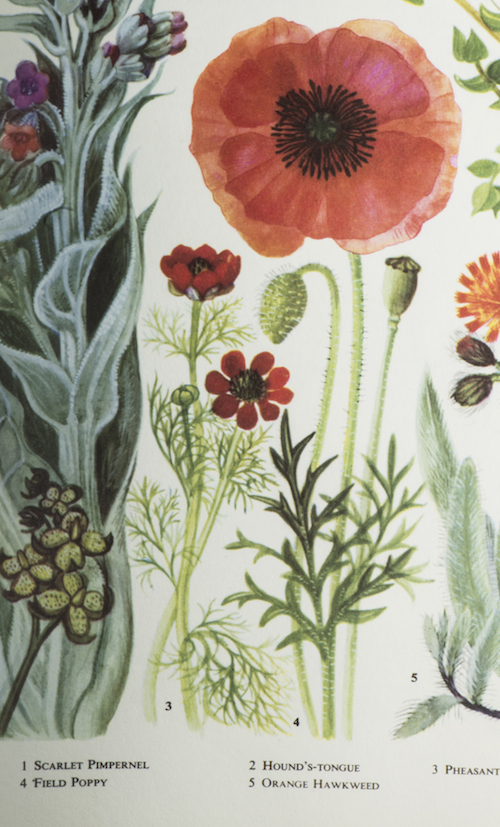
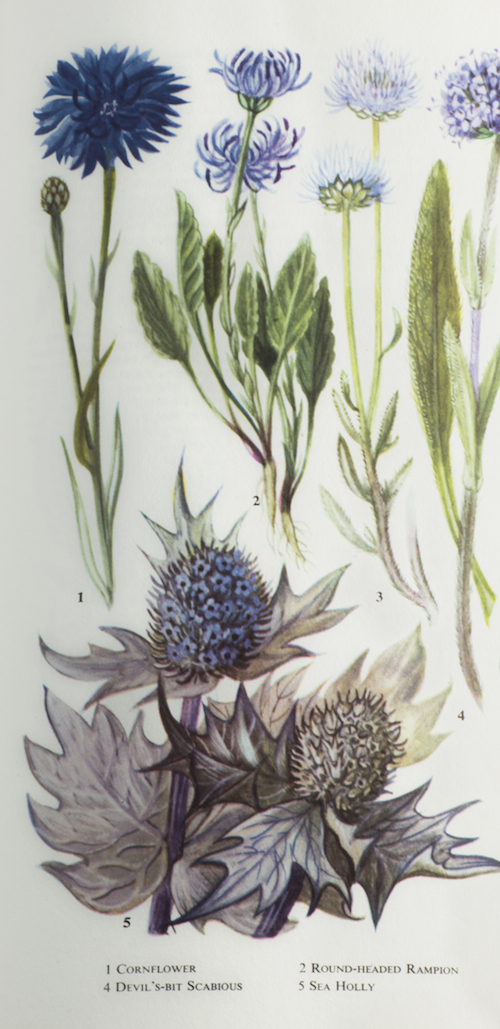
8. Yaddo Dust.
After their 1959 road trip across America, Plath and Hughes were guests at Yaddo, the artists’ colony in upstate New York. They arrived at the colony on September 9 and remained there until November 19. Plath had a productive stay: she wrote the poems that completed her first book, The Colossus. Poet May Swenson was a guest at Yaddo at the same time. Plath wrote this about her in her journal: “Independent, self-possessed M.S. Ageless. Birdwatching before breakfast. What does she find for herself? Chess games. My old admiration for the strong, if Lesbian, woman. The relief of limitation as a price for balance and surety.” She also referred to the freckled Swenson as “a tough little nut.” One night, the tough little nut tried to teach Sylvia how to play chess, but Ted’s bedtime was 9:30 and he wanted his wife beside him. This exasperated Swenson. She thought Hughes terribly masculine on the one hand, immature on the other. She also thought Sylvia was a decent match for him.
Plath’s studio was Room 8, on the top floor of West House, sunny, with a view of pines and a field. When poet Catherine Bowman stayed at Yaddo in 2005, she was assigned “Sylvia Plath’s studio.” On August 11, Bowman and artist Andrew Ginzel collected dust from Room 8; Ginzel then inserted the dust into twenty-four labeled vials. Catherine kindly gave me one. I can count the number of poets whose Yaddo dust I would want on—well, one finger.
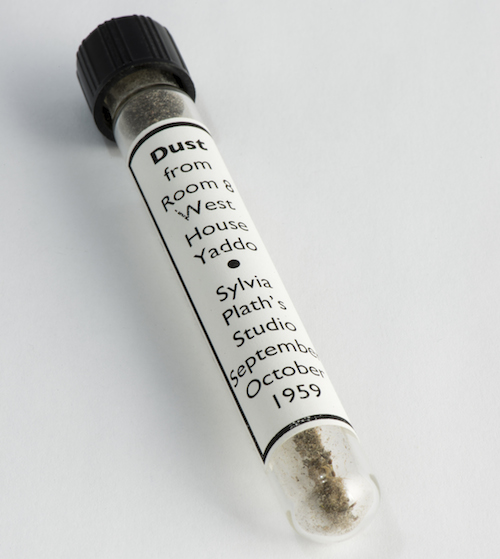
9. Yew Tree.
Plath wrote “The Moon and the Yew Tree” on October 22, 1961, less than two months after moving to Court Green. Everything in the poem is true: her property was separated from an adjacent church (St. Peter’s) by a row of headstones; on Sunday eight bells would toll; an ancient yew tree grew in the church graveyard. “I live here.” She did, literally. It’s like she’s trying to convince herself it’s real, it’s all so new: “I live here.” Plath thought it was a lovely church, despite her “heathen” nature. That’s in the poem, too: her affinity is with the wildness of nature, not religion. On November 5, she wrote to Aurelia: “Went to the Anglican chapel evensong again tonight—it’s a peaceful little well on Sunday evenings, & I do love the organ, the bellringing & hymn-singing, & muse on the stained-glass windows during the awful sermons. The three windows, lit up on Sunday evenings, look so pretty from our house, through the silhouettes of the trees.” She doesn’t mention the yew tree specifically in any of her letters; she saved that for the poem.
I’m a lucky Plathophile. A friend of mine made a pilgrimage to Court Green in Devon and brought back a cutting of Plath’s famous yew tree for me. Then another friend made a pilgrimage to Court Green and brought back another cutting for me. I keep them in a handcrafted wooden box (painted red, of course) on my desk. But one mustn’t be greedy. I have such an abundance of yew, I’m going to give some of it to the poet Robyn Schiff. She’s not quite the Plathophile that I am, but I know she’ll appreciate it.
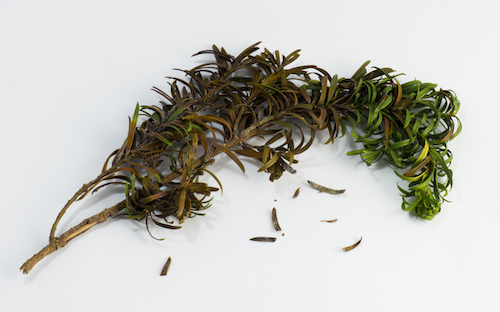
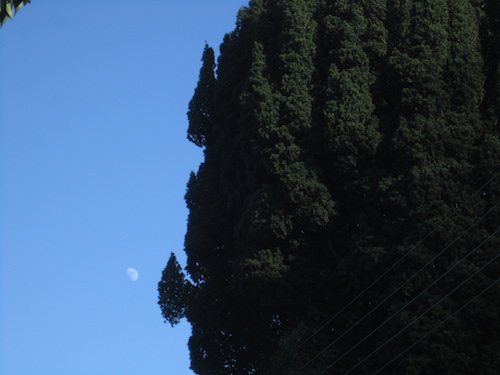
All photographs by Cora Jacobs (with these exceptions: Plath and her children, my notebook, the moon and the yew tree). I am grateful to Cora for her assistance.
David Trinidad is the author of more than a dozen books, including Peyton Place: A Haiku Soap Opera ...
Read Full Biography

